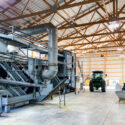As Josh Christensen walks around his farm, the evolution of the hops industry is apparent all around him. For starters, his farm, Christensen Hop Farm, is in Nebraska. A few years ago, that didn’t seem possible (more on that in a bit). Soon, the dozens of poles with wires strung between them, which come in the middle of summer, will have 20-foot high hops plants tied to them, creating massive walls of green like nothing else in the Midwest.
“Really windy days could be hard on hops,” Christensen said. “That’s why I picked this location. It’s behind the trees a little bit to protect from the wind.”
As we walk past said trees to the barn, a gray-paneled two-story that seems standard to every American farm, he offers me a beer. It’s a Midwest Haze IPA, brewed in Glenwood, Iowa. It’s, of course, made from one of his varieties. As we sip, he explains the origins of his business.
“I’d brewed beer and then I’d farmed my whole life,” Christensen said. He learned to farm hops from his childhood friend’s dad.
Sharing a beer with a hops farmer whose product helped create it is an experience historically only found in the Pacific Northwest. Hops — the flowers used to give beer its flavor and bitterness — love moderate climates with nutrient-rich and dryer soil. That sums up the three main hops hotspots: Washington, Oregon and Idaho.
But craft beer production has exploded. According to the Brewers Association, the number of barrels of craft beer produced in the U.S. in the last 15 years has more than tripled, from just over 7 million barrels to 24.7 million barrels of beer. That’s approaching 800 million gallons of craft beer. And that doesn’t even include the big brewers like Anheuser-Busch Companies, Miller Brewing Company, and Coors Brewing Company, who have also seen sales increases.
And to make all that beer, you need hops — gobs and gobs of hops. According to a 2021 report from the Hops Growers of America, the acreage devoted to hops in the US has increased by 109% in the last decade. While the bulk of that growth has been in Washington, Oregon and Idaho, there has been steady expansion into middle America. Hops farms have sprung up from Ohio to Minnesota, with Michigan recently taking the crown for devoting the most acreage to hops in the Midwest. Christensen’s farm is part of all that growth.

Why The Midwest?
Growing hops in the Midwest is different. Hops plants can’t survive a winter frost, so warmer coastal regions offer a year-round growing season. Coastal farms are able to run their machines 24 hours per day, 365 days per year and turn out hops in massive amounts, which keeps brewers happy and returning. The established industry in that region also allows mass producers to develop relationships with big brewing companies to distribute their products.
But with big industry comes big risks.
“The biggest reason people started growing hops outside of the Pacific Northwest… mostly due to how in 2006, there was a fire in a hop warehouse that created a hops shortage,” Christensen said. “The price of hops spiked. So that made everyone outside of there think, ‘Oh here’s the newest thing I can get into and make a buck.’”
Slowly, more hops farms began popping up in the Midwest. Although the climate doesn’t allow for year-round growing, the hotter summers help the plants grow faster. On any given day, plants are also exposed to the sunlight longer here than in the Pacific Northwest. Midwest soil is also more fertile and better for growing these types of plants than other regions.
Because of all this, Midwest hops taste different. There are different types of hops that grow in different parts of the country. The Midwest is known for hops that are fruity-tasting, “which is a good flavor to have in a hop these days,” Christensen said.
And that flavor is unique. It doesn’t come naturally from any other region. Plus, local brewers save money when working with area hops farmers. There’s less shipping. They’re supporting local businesses. And, they’re utilizing unique flavors and the ideal cropland.
“With craft beer everywhere, there’s enough of a market for it where all of the hops I sell are within 200 miles of here,” Christensen said.
But hops farms are different from other crops in operation and appearance. The dry ground is covered in dirt and various plant stems. Behind Christensen’s large gray barn is a six-acre clearing with 20-foot poles sticking out of the ground every few feet or so, all connected by strings on the ground and in the air.

Inside the barn, there are large green tractors and machinery that take up half of the space. A system of tubes and conveyor belts used to clean and sort hops touches the ceiling of the barn. The rest of the area is filled by a boxy, wooden structure constructed from bare plywood. This is used as a drying room in the final steps of preparing the product.
Christensen didn’t start with all this.
“I started with about 80 plants at my house,” he said.
That was in 2017. He and his wife Ronee decided to grow some to see what would happen. He had them in his backyard, but once the plants grew over 15 feet he knew he needed to move to something bigger.
“I moved everything down here just because you work 14 feet in the air when you string the plants. That’s a lot easier here,” he said.
Christensen plans to continue running his farm while the demand for his hops remains. Taste some of his homegrown hops by heading to any one of the breweries he supplies. Catch that fruity flavor and you’ll know – that’s the Midwest difference.
Hops Farming Process
Hops farming — simplified — happens in six stages:
- Planting takes place after the last frost of the winter, typically in May in the Midwest. In the Pacific Northwest, planting occurs year-round because of the lack of frost. The root cuttings are placed about seven feet apart near trellises and the soil must be watered deeply.
- The dirt around the plants is then covered in straw or mulch to control weed growth.
- Hops grow bines, not vines. It’s more of a tall, twisting plant than your typical grapevine. Once the bines grow, the farmer must train the bines to climb the trellis by wrapping them around with string attached to the ground and the top of the trellises.
- Most of the flower cones grow on the upper part of the branches and are ready to be harvested in late summer, or approximately five months in coastal climates. The growing season is shorter in the Midwest because of the limited warm weather. Flower harvesting takes place in mid-August at Christensen Farm.
- When the cones are ready to be harvested, they are separated from the flower, sorted, cleaned and dried out. This is done by taking flowers and running them through a machine that separates the cones and cleans them. The cleaned cones are then dried using a well-ventilated room, direct sunlight or ventilating machine.
- The dried cones are stored in airtight containers in refrigerators or freezers until they’re ready for use.
Challenges to Farming Hops
There are various challenges to face when it comes to farming hops. These include, but aren’t limited to, the following:
Bines not climbing the trellis: If the farmer fails to have the bines grow on the trellis or they fall off, the plant will be unusable. This is why windy climates are not ideal for hops farming. The ideal location for a hops farm is a clearing away from buildings or any other tall structures, to avoid the excess wind.
Viruses, mildew and mites: Plants can catch viruses and mildew from not being monitored regularly or overwatering the soil. Climates that have above-average rain levels make it difficult to maintain hops plants.
Difficult to kill: Hops plants left untouched will survive up to 50 years. Average weed killers do not work on them. Hops plants will naturally die in the winter in the Midwest unless they need to be killed early for spatial purposes. In climates without frost, the plants will live until they are killed by the farmers.
“It’s a pain in the ass to kill these plants,” Christensen said while shaking his head.
Fast growing: Hops plants can grow up to a foot per day. If there isn’t frequent monitoring, they can grow off of the trellises and fall.

